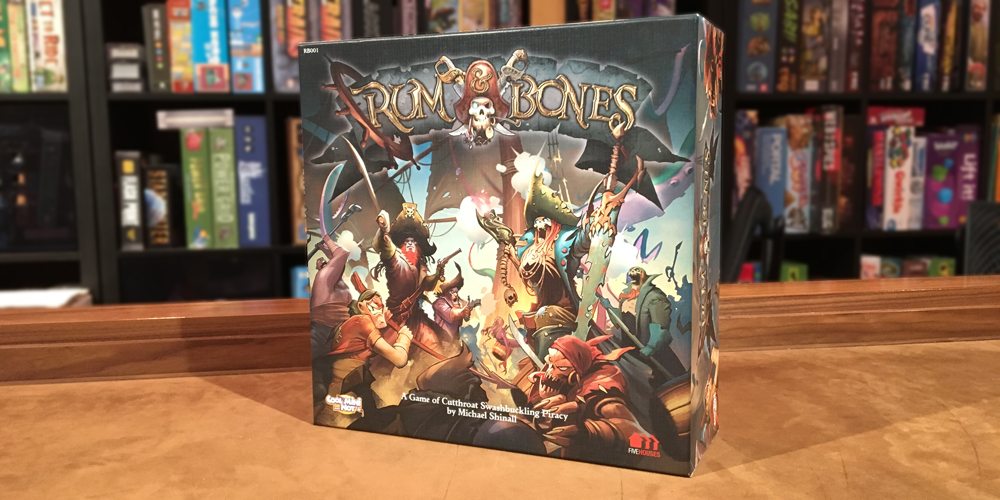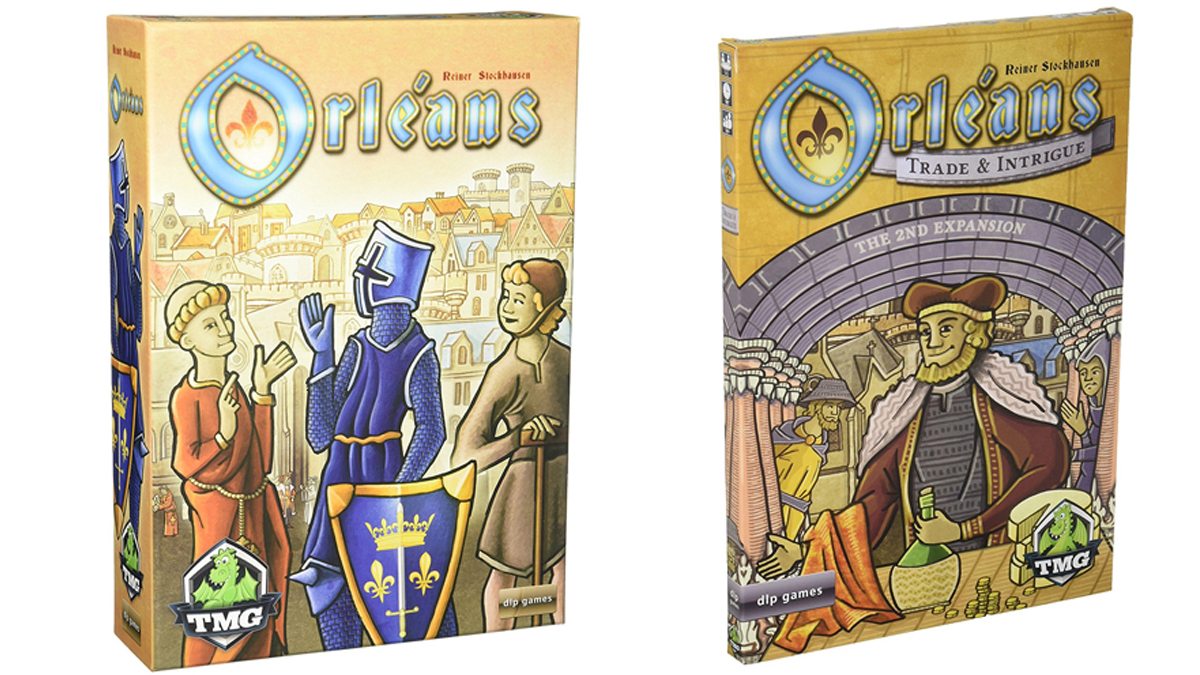
Images: TMG
Hire farmers, monks, scholars, knights, traders, craftsmen, and boatmen to build a mercantile empire. You choose how to play, whether it’s a simple wealth-building session, a journey to buy and sell goods, a quest for promoting the greater good, or a jolly round of sabotage, fraud, and arson! There are a lot of components, but don’t let that trip you up. Orléans is great fun.
What are Orléans and Orléans: Trade & Intrigue?
Orléans is an action-packed game of becoming an economic tycoon and leader. Much like a deck-building game, Orléans is a bag-building game, and improving your purse brings you closer to victory. With the Trade & Intrigue expansion, Orléans becomes ever more complex, creating new challenges for veteran players.
With Orléans and Orléans: Trade & Intrigue, 2-4 players ages 14+ can play for 90+ minutes in a strategy-heavy medieval conquest. There are 5 sets of rules to play in any combination, meaning there are 27 ways to play. Be warned, though: The more elements you use, and the more players at the table, the longer the game gets. Using all elements with 4 players can easily land you in a 3+ hour play session.
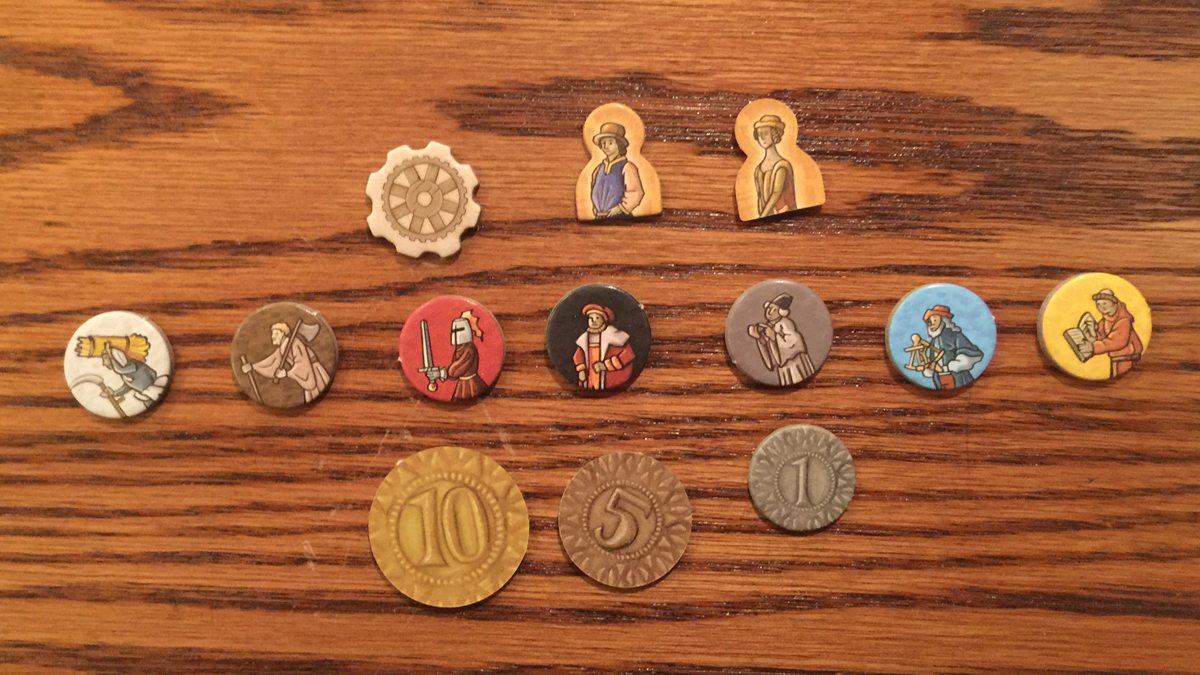
Photo: Rory Bristol
‘Orléans’ and ‘Orléans: Trade & Intrigue’ Components
There are a lot of pieces in the base game, and the expansion doesn’t fall short despite its slender size. Here’s a full list of the 395 components in the base game:
- 1 Large game board
- 1 Beneficial deeds game board
- 4 Player boards (Red, Yellow, Blue, and Green)
- 4 Followers bags
- 4 Merchant tokens
- 40 Trading stations
- 28 Wooden cubes
- 104 Character tiles
- 16 Farmers
- 14 Monks
- 14 Scholars
- 14 Knights
- 10 Traders
- 10 Craftsmen
- 10 Boatmen
- Color-marked tokens specific to the players
- 4 Traders
- 4 Craftsmen
- 4 Boatmen
- 4 Farmers
- Color-marked tokens specific to the players
- 90 Goods
- 24 Grain
- 21 Cheese
- 18 Wine
- 15 Wool
- 12 Brocade
- 16 Technology tiles
- 14 Citizen tokens
- 47 Coins
- 20 Place tiles
- 18 Hourglass tiles
- 2 Overview tiles
- 1 Start player token (Though some come with 2 for some reason.)
- 1 Rulebook
Orléans: Trade & Intrigue has a further 73 components:
- 1 Alternate beneficial deeds board
- 1 Intrigue board
- 3 Place tiles
- 10 Cover tiles
- 23 Order cards
- 34 Hourglass tiles
- 1 Rulebook
Each of the tiles is thick glossy cardboard, fairly standard in quality with nice illustrations.
Many tiles are playable, each interacting with other elements. Character tiles are double-sided circles, and match circular place markers on the game boards. Goods are squares with a good marked on one side and a crate on the other. Technology tiles are shaped like gears, and can replace character tiles during play. These two types of tiles are the majority of resource management, and form the core of the game.

Photo: Rory Bristol
The Overview tiles are quite handy. They are especially helpful to keep the game moving, so people don’t look at the rules to check for how points are awarded, or what the turn order is.
Player’s boards are where the character and technology tiles are played. When appropriate characters are assigned, various events can occur. Whether this means hiring another character or acting for the greater good, there’s always a benefit to placing character tiles well.
The two beneficial deeds boards and the intrigue board have actions which activate each time a character tile is sent over via the players’ boards.

Place tiles are perhaps the most interesting pieces. These tiles can only belong to one player and are collected through play. Each tile has one or more place for a character tile to be played, activating a unique ability, in addition to the player’s board.
Hourglass tiles are stacked and played at the beginning of each round. Each represents a natural or social event which might effect the economy that round. The expansion’s 34 tiles replace the base game’s 18 when used.
Citizen tiles are only accrued to be scored at the end of the game.
The merchant tokens, trading stations, and cubes are wooden. These pieces are perfectly simple.
Each player’s merchant bag is color-coded and has a suede-like feel. I hate these, and I cannot understate that. They are too big and feel gross to the touch. I’m currently making smaller replacement bags. I think most people wouldn’t mind them, but in a game with so many components, having 4 replaceable components is too easy to pass on.
The order cards are the only laminated cards, and can be added to any other setup. Go to the place indicated and offer up the materials required to claim the trade. This allows one to gain large payouts of points at once.
How to Play Orléans and Orléans: Trade & Intrigue
Orléans is a complex game, right from the start. No part of it is quick, but it’s worth the trouble.
Setup
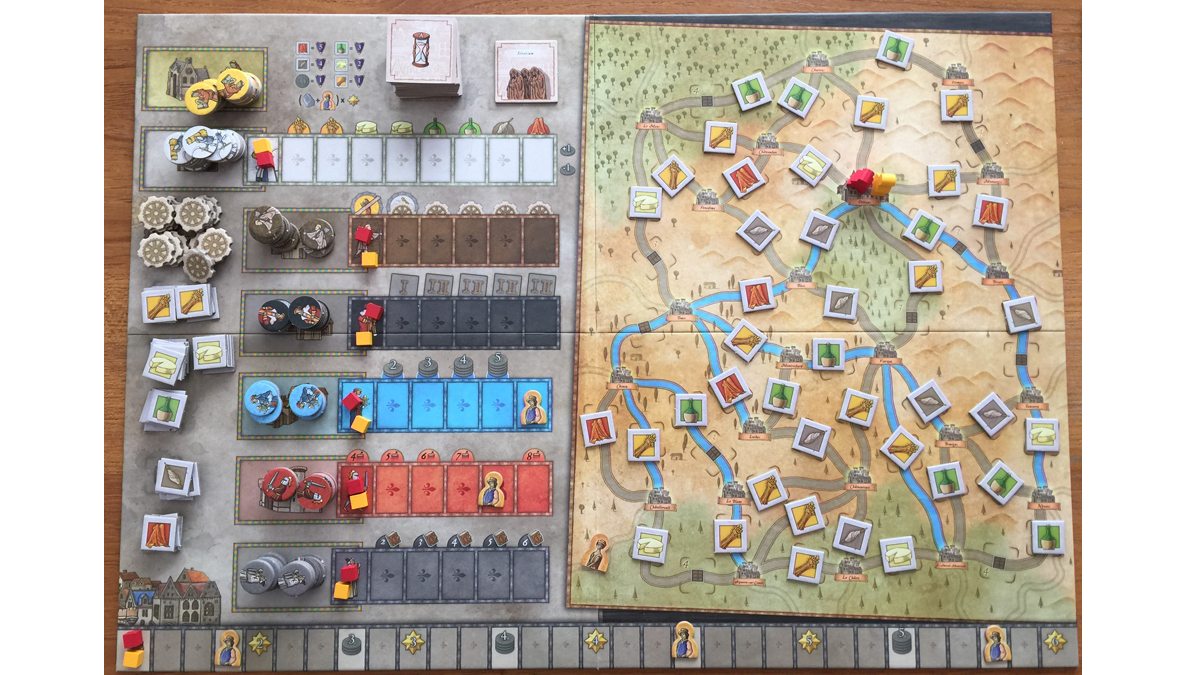
Photo: Rory Bristol
Setting up Orléans can take over 10 minutes, unless everyone is pitching in. With help and experience, that can be brought down under 5 minutes. Some parts are set up permanently. Each of the players gets a board and color-matching bag which contains their starting character tokens, trading stations, and merchant.
The right side of the main board has slots for goods to be placed in, which is done randomly. For this tedious step, all the goods tiles are to be shuffled. Yes, all 90 tiles. Then the rest of the tiles are sorted, every game, into separate piles. This step does not work for me. I can’t stand spending the time sorting out all the tiles back into 5 piles each time. Instead, we just randomly fill the slots with tiles from the pre-sorted tiles. We just don’t put any type of tile next to another, and it’s fine.
The left side of the board is much more straightforward, thankfully. The remaining goods are stored in their own places, followed by all the character tiles. Other than monks, each character has a matching track to show how many of that character a player has acquired. Advancing on these tracks have individual bonuses. Players each place their wooden cubes, one for each track, and one on the Development track at the bottom of the board. The technology tiles go in a pile to the left of the Craftsmen. Finally, the hourglass tiles go in a stack of 18 at the top.
The Beneficial Deeds board is set up to the side. The Citizen tiles are placed on their blanks between the different boards and tracks. The last one is set aside.
Variant setups
With the Orléans: Trade & Intrigue components, one can swap out components to change things up.

Photo: Rory Bristol
The Beneficial Deeds board can be exchanged for the new Beneficial Deeds board or the Intrigue board. This will affect the number of citizen tiles allocated. It is possible to play with both new boards, but I don’t recommend it. We did so for the game pictured throughout this post, and it was hectic and cumbersome. There are 10 “cover” tiles, which cover up the spaces which are removed in 3- or 2-player games. That’s not enough for both boards at once, but will cover you (snerk) the rest of the time.

Photo: Rory Bristol
The Orders deck of cards is placed on the table, with 5 orders revealed at a time.
The 34 new Hourglass tiles can replace the 18 Hourglass tiles from the base game. They cannot be played together. The setter-upper takes 4 “A” tiles, 4 “B” tiles, 4 “C” tiles, 4 “D” tiles, and the 2 Silentium “tiles”, and arranges them in an alphabet sandwich. Silentium is the top and bottom tiles, and the rest are arranged, face down, with A on top, followed by B, C, and D below. Since there are 8 tiles in each letter category, there are 70 possible combinations in each category, and literally millions of combinations of 16 tiles. This adds a freshness to every game which is to be envied.
The 3 new Place cards are added to the mix of existing place tiles, and can remain there no matter what expansion(s) you’re playing with.
Mechanics
The mechanics, for such a complex game, are very, very simple. This is the saving grace of the game. There are a lot of options, but once a choice is made, the work is quick.
Events (Hourglass tiles) are flipped at the beginning of each round. These have unique effects that go into effect after players have taken their Actions. This means you have the opportunity to prepare for the event, but there is some luck involved here.

Photo: Rory Bristol
Players interact directly with their own boards (and through those, the other boards) by placing character tiles in “Action spaces” on their boards. Each turn, the players draw a number of characters from their bag, and put them in the “Market,” a row on their player’s board. Players start with 4 character tiles, but they can easily get more.
The Player’s Boards allow you to take a variety of actions. This begins by allocating Character tiles to a location, and when a location is full, it unlocks an action in a later phase. (See phases listed under “What to Do on Your Turn.”)
Locations
There are 5 locations that allow you to get new character tiles. The Castle allows one to get a new Knight by allocating a Farmer, a Boatman, and a Trader. The Farmhouse allows you to hire a new Farmer by allocating a Boatman and a Craftsman. The Village allows you to hire any one Trader, Boatman, or Craftsman by allocating a Farmer, a boatman, and a Craftsman. The University lets you hire scholars by allocating a Farmer, a Craftsman, and a Trader. Finally, by allocating a trader and a scholar (which can’t be done in the first turn, because you must first acquire a scholar), you may hire a monk.
To affect the right half of the board, you can allocate characters to the Ship, Wagon, or Guildhall. If you use a ship, you can travel along the French countryside by boat. When you use a Wagon, you travel by road. When you travel by either means, you can improve your standing by collecting (no more than) 1 good on the road per movement. Collecting these goods is one method of gaining points. If one uses the Guildhall, they can build a Trading Station in their current location. Trading stations are worth points at the end of the game.
Beneficial Deeds and Intrigue
To affect the Beneficial Deeds boards or the Intrigue board, one sends Character tiles through Town Hall. There are only two Action Spaces on each player’s board for this action, so you can only take a couple actions per round.
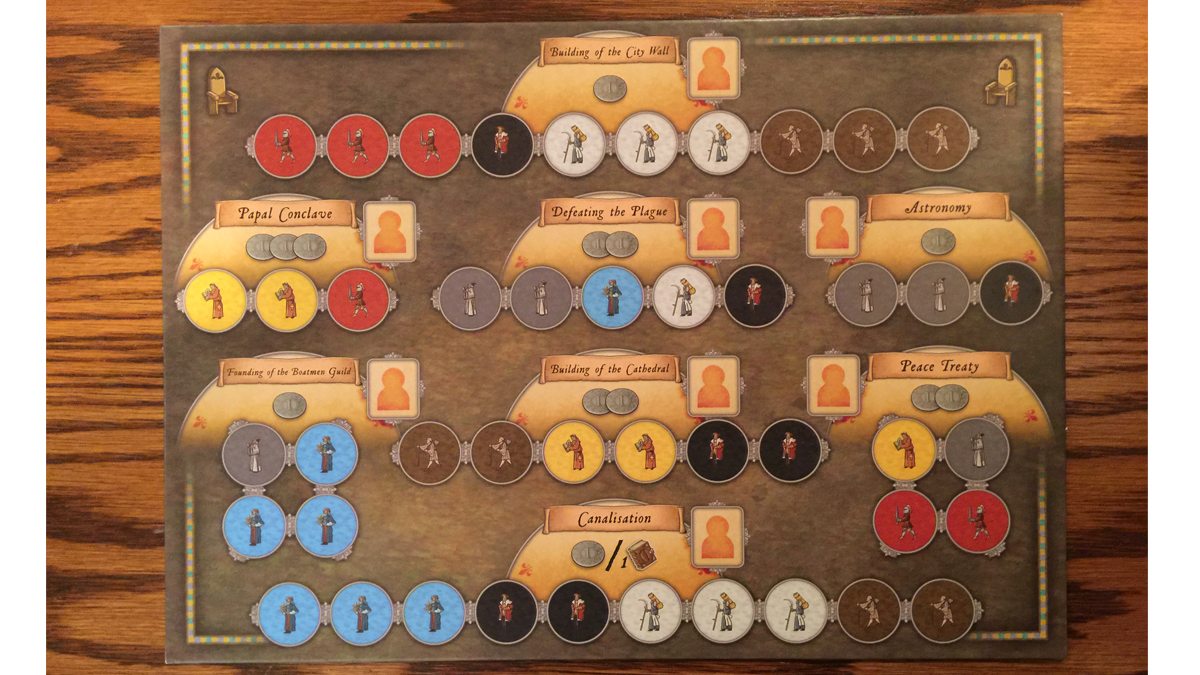
Photo: Rory Bristol
The base game’s Beneficial Deeds board allows you to get money or improve their Development score by allocating members to respective locations. Locations here include “Building of the City Wall” and “Astronomy.” When a location is full, the last player to place a Character there gets a Citizen tile.
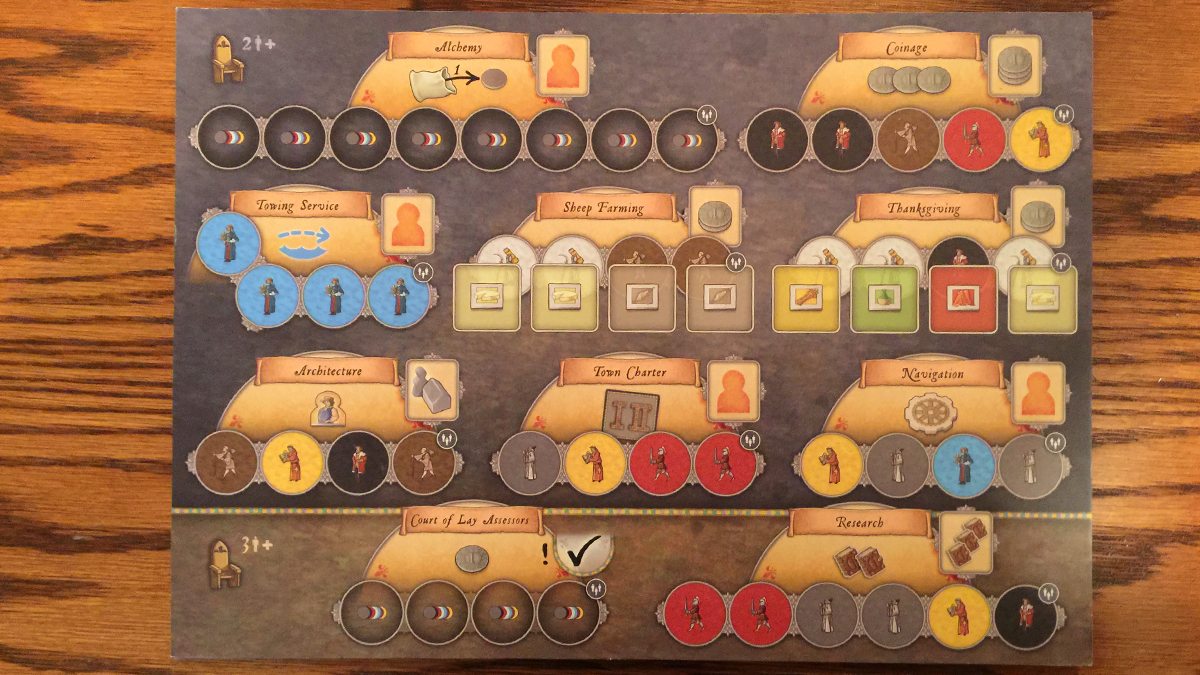
Photo: Rory Bristol
With the Trade Beneficial Deeds board, players complete 10 new tasks, and get very different rewards. Instead of money, character tiles allocated to Architecture get Citizen tiles. Characters allocated to Navigation get Technology tiles! Rewards for filling up these new locations include Trading Stations, improvement on the Development track, and coins.

Photo: Rory Bristol
The Intrigue board is very different from the Beneficial Deeds boards. Characters allotted to this board via Town Hall have negative effects on your enemies instead of beneficial effects on yourself. There are 9 new means to attack your opponents, but I have a few favorites. The Kidnapper nets you a coin, but sends a player’s Merchant token back to Orléans, which can really mess someone up if they’re doing a lot of travelling. The Tax Collector forces other players to give you coins. The spy, though, is particularly nasty. They can steal a technology tile from an opponent and place it on their own player’s board in the same Action space. If this completes a location for you, you can use it! If it renders their location incomplete, they can no longer take that action.
Tracks
On the left side of the Main board, there are 7 tracks. Players move along these tracks by completing locations. When a player moves forward on any of the colored tracks, they also get a matching Character tile. Each of the characters (save the Monk) have their own track. Advancing on those tracks have unique benefits. The Development track has different mechanics, explained below.
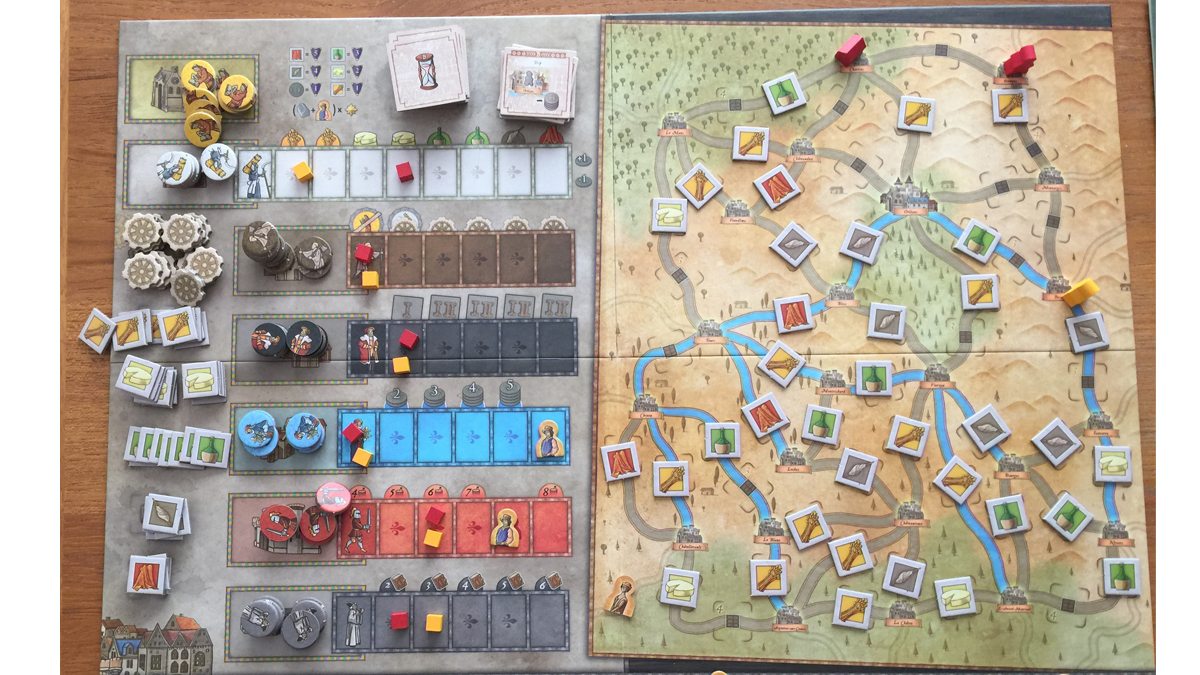
Photo: Rory Bristol
Advancing on the Farmer’s track awards you goods, and changes your standing for the Census in Phase 2 of each turn.
Advancing on the Craftsman track gives you Technology tiles. These tiles can replace any space on the Player’s board or their Locations except for spaces reserved for Monks. The first Technology tile must replace a Farmer, but since nearly every location on the Player’s board takes a Farmer, this is still quite handy!

Photo: Rory Bristol
Advancing on the Trader’s track allows one to acquire Place tiles. These tiles include beneficial uses such as producing brocade, and are unique. This is one of the best ways in which a player can establish synergy within their own purview, allowing them to generate their own resources.
Advancing on the Boatman’s track grants coins. Completing the last advancement does not net coins, but the first player to do so is awarded a Citizen tile.
Advancing on the Knight’s track allows the player to pull more tiles from their purse each turn. This is one of the best forms of advancement in the early parts of the game, as the ability to place tiles depends entirely on being able to draw them. The 4th time you advance, you do not increase the number of tiles drawn. Instead, the first player to reach this point is awarded a citizen tile. If one advances to the fifth place, they can draw 8 Character tiles every turn.
Advancing on the Scholar’s track moves you up on the Development track. You can advance 20 spaces by this method, putting you past the 4-star Development threshold.
The Development track has a few quirks. It’s the only track which awards multiple Citizens (3 total). It also awards coins at various thresholds. Finally, your progress on this track indicates how many points your Trading Stations and Citizens are worth. If you fully Develop your little empire, each Trading Station and Citizen is worth 6 points. This is a steady way to guarantee points, but can drain your resources getting there.
Goods

Photo: Rory Bristol
While Goods don’t do too much on their own, they’re a critical part of several other mechanics. They have inherent point values, can be exchanged for Orders, can be gained or lost through a number of means, and are one way of tracking your points along the way.
What to Do Each Round (x18):

Photo: Rory Bristol
Phase 1: Hourglass
At the beginning of the round, an Hourglass is flipped over. A few of these events go into effect right away, but the rest don’t change anything right away.
Phase 2: Census
The player in the lead on the Farmer’s Track gets a coin. The last player has to pay a coin.
Phase 3: Followers
Each player draws Character tiles and places them in the Market. The Market has a cap of 8 tiles, so no more than 8 can be drawn or played on a given turn. If a player would get to draw more tiles than there is space, they lose out.
Phase 4: Planning
In this step, everyone plays their Character tiles on their Player’s boards. This is meant to be done in turn order, but that’s often not important. Disclaimer: If you are playing the Intrigue board, it may be best to take these placements in turn, as decisions may change as this phase progresses.
Phase 5: Actions
Beginning with the Start player, everyone takes turns taking Actions. If you’ve completed a Place, you can activate it on your turn. You may complete these in any order, but only one per turn. If you pass, you can take no more actions. If you complete an Order (when using them), that must be your last action. When you complete an action, remove the Character tiles from their Places, and return them to your purse. Technology tiles don’t get returned, so they’re a permanent upgrade!
After passing, you may place Technology tiles.
Phase 6: Event
Resolve the Hour Glass tile, which affects all players.
Phase 7: Start Player
The Start Player passes the Start Player Token to their left. If there are remaining Hour Glass tokens, begin with Phase 1 again.
Scoring:
To find out who wins, you tally up the points. Citizens and Trading Stations are worth their Development value in points. Goods are worth various points, with Brocade being the best (5 points) and Wheat being the least (1 point). Coins are worth their value in points. Finally, Orders are worth their listed value.

Just so you can see the scores of two players, here are the results of a game between Red and Yellow.
Yellow only ended up with one Citizen, so her Development value had very little effect, yielding only 5 points. However, she collected a lot of goods throughout the game, mainly Brocade, which gained her a whopping 60 points. She also collected coins when presented with the chance, which gained her another 26 points, for a total of 91.
Red invested in Trading Stations and focused on getting Citizen token rewards. To aid this, he chased Development until the end of the track, so each would be worth 6 points. Therefore, his Development accrued him 54 points. He completed an Order for 12 points, but this left him with only 8 points in good. Finally, he used the Beneficial Deeds board to get a staggering 42 Coins. His total was 116, a whopping victory over Yellow.
Why You Should Play Orléans and Orléans: Trade & Intrigue
Orléans and Orléans: Trade & Intrigue are games for people who like strategy. If you’re tired of Candy Land, then most any modern board game will do you. If you’re tired of games like Magic: the Gathering, Munchkin, or Settlers of Catan, then you’re barking up the right tree. Orléans and Orléans: Trade & Intrigue combine the best features of deckbuilding/poolbuilding, resource management, worker placement, and long-game strategies into one beautifully designed game.
The good: The game design is amazing. Playing through it is always fun, even if it’s long. Just don’t play it with your friendly neighborhood ditherer.
Other than changing the way we complete the setup (see above) for the map, we generally follow the directions to great fun all around. Scoring is easy and straightforward, so you always know where you stand.
The bad: Those bags. Thankfully, it’s easy to replace them. I could even use dice bags. I’m obsessed with my games, though, so I’ll make something a little more unique.
Also, never take this to game night unless it’s what everyone is there for. And never, ever, play it as the first “modern board game” someone is playing. Set them on something easier and more fun like Munchkin if they’re testing the waters, or Ascension if they’re looking for a (manageable) challenge.
The Box:
This is a pass/fail for me with many games. In this case, I’m ultimately torn.
Here’s the thing. The Orléans box has no insert. None. The Orléans: Trade & Intrigue expansion is small enough to fit in the base box, but that’s not exactly a good thing. Any other game, I’d be finding a new box or storage solution, because little ruins my enjoyment of a game like sorting through every tile every time I play. In many cases, I’ve gotten rid of games that had boxes that were too big, small, or inefficient, and weren’t worth getting a new container for them.
There’s another side to this leaf though: Together, Orléans and Orléans: Trade & Intrigue weigh over 4 pounds. I don’t want a bigger, heavier box, just to have an insert. They come with plenty of little bags to store things in, so I can sort everything out for easy setup. I store the Character tiles in pairs (Farmers and Monks together, and so on), and store the goods in separate bags. The Hour Glass and Place tiles are the tedious part, because there are so darn many of them and they don’t fit in little bag. Thankfully, the box is packed so full, I don’t really worry about them shifting around.
Click here to see all our tabletop game reviews.
If you’d like to stay up-to-date with all of our tabletop gaming coverage, please copy this link and add it to your RSS reader.
Disclosure: GeekDad received a copy of this game for review purposes.


